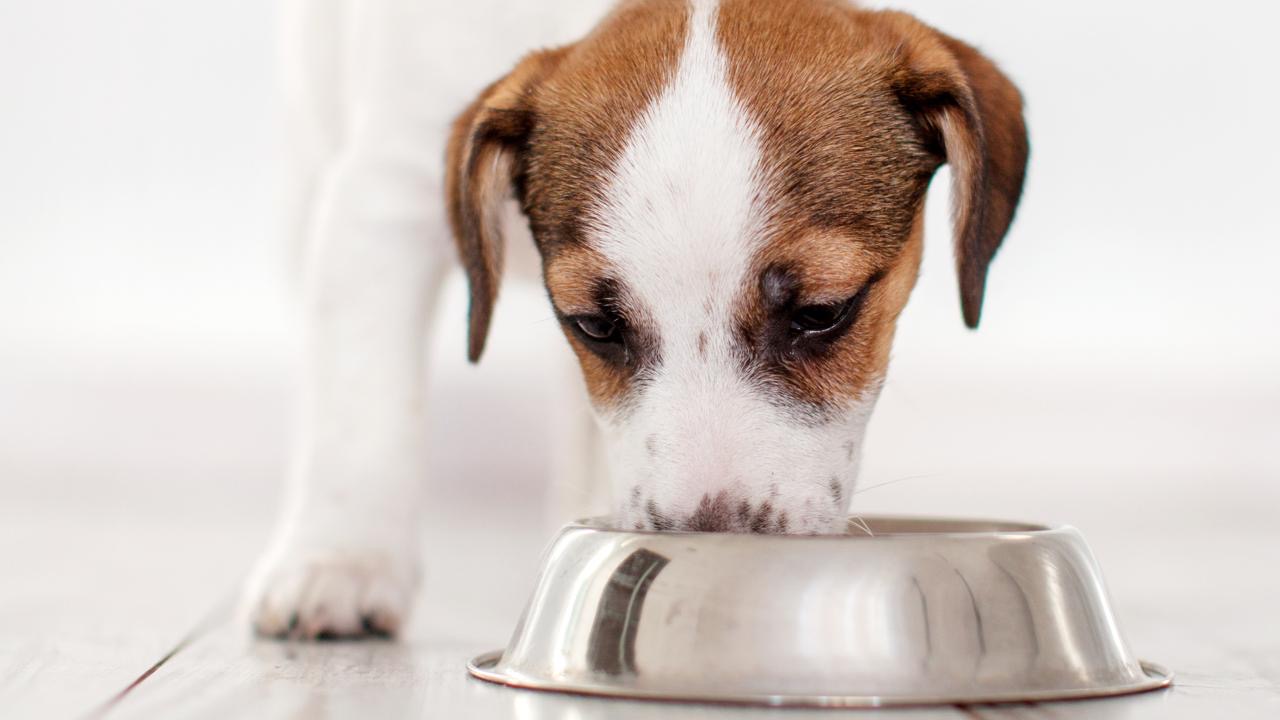-
£19.99

Puppy Nutrition 101
- March 30, 2021
- 9 min read
Puppy Nutrition 101
The dog is unique amongst other mammals in that it has the widest range of normal adult body weight within one species. Many breeds will reach 50% of their adult size within 5-6 months. Some breeds will be fully grown by 8-12 months, some 12-18 months, and others 18-24 months. With this incredible range, it’s no surprise that puppyhood is in fact a very sensitive period, and one that we need to get right. Here at My Pet Nutritionist, we are incredibly lucky that we support many owners in choosing the right nutritional plan for their growing puppy. But we thought we’d compile a brief guide to some of the most important things to consider for the growing puppy.Growth and Development
After nursing, post-weaning growth is the most nutritionally demanding period in a dog’s life. For large and giant breeds, the length and speed of their growth poses an even higher nutritional demand. By maturity, most dogs will have increased their birth weight by 40-50 times. How amazing is this?
But it also poses something to be very conscious of.
Physical Growth
How are bones formed?
Also known as ossification, bone formation is a process where new bone is produced. Look at any large breed and it is clear to see how much new bone needs to be produced from birth to full skeletal maturity.Bone starts as a cartilage model which gets slowly replaced. Osteoblasts are the cells that form new bone. They secrete osteoids. Osteoid tissue is simply unmineralised bone tissue.
Soon after the osteoid is laid down,inorganic salts are deposited which forms the hardened material that we know as bone. These inorganic salts include calcium and phosphorus.
Bone formation proceeds outwards from ossification centres; short bones tend to have one in the middle whereas long bones typically have three, one at each end and one in the middle. Ossification, or bone formation continues until there is a thin strip of cartilage left at each end of the bone. This is known as the epiphyseal plate, or growth plate in the dog world. When the bone reaches full adult maturity, the cartilage is replaced with bone and“sealed” for want of a better word.
It is therefore no surprise that certain minerals are necessary for physical bone growth, along with some vitamins.
Calcium is the most abundant mineral in the body; the majority of which is contained in the skeleton. Phosphorus is the next most abundant; also found in bone. Although they have separate functions within the body, being so closely interrelated, they are usually considered together.
Calcium is involved in constriction and dilation of blood vessels, nerve impulse transmission, muscle contractions(including the heart), secretion of hormones and blood coagulation. It also plays a role in fluid balance in cells (contributing to homeostasis).
A diet grossly inadequate in calcium, results in hypocalcemia. The body will remove calcium from bones to ensure normal cell function in the rest of the body. This leads to weakened bones. Hypercalcemia is a little more uncommon, but it is most often linked with overactive parathyroid gland function.Phosphorus is essential in cell growth and differentiation, energy use and transfer, fatty acid transport and amino acid and protein formation. In general, phosphorus is better absorbed from meat products than plant products. Phosphorus found in meat is mainly in its organic form; in plants it is in the form of phytic acid. Phytic acid impairs the absorption of iron,zinc and calcium and has been linked to mineral deficiencies. It is often referred to as an anti-nutrient.
Deficiencies of calcium and phosphorus are unusual, but imbalance is noted. In unbalanced diets, calcium deficiency can develop alongside high levels of phosphorus.
Low calcium levels stimulate the release of parathyroid hormone, which increases the production of the active form of Vitamin D.This results in an increased bone reabsorption to restore calcium levels. This eventually leads to bone demineralisation and a loss of bone mass. In dogs, this is more commonly noticed in the mandibles (jaw bones), leading to tooth loss and periodontal disease.
Attention is most often paid to the calcium:phosphorus ratio. The note to make is that organic sources of both minerals are slowly and less efficiently absorbed; so, in fresh fed dogs this is less of a concern in terms of excess. Phosphorus found in meat products however is more efficiently absorbed than that found in plants.
Findings here
Other nutrients relevant to skeletal development include vitamin D, vitamin A, copper, zinc and manganese. Deficiency or excess in these have regularly been linked to abnormal orthopaedic development.
But, as we know, it is not just the bones in puppies that grow – it is in fact every part of their body!
What do puppies need to grow?
Protein
Proteins are large, complex molecules composed of hundreds to thousands of amino acids.They are literally the building blocks of the body. Protein is required in the diet to provide a source of amino acids to build, repair and replace body proteins.Proteins in the body have numerous functions.
- Major structural components of hair, skin, nails, tendons, ligaments and cartilage.
- Hormones are composed of protein molecules – these include insulin and glucagon which are key to maintaining blood sugar levels.
- Proteins are found in the blood– for example haemoglobin carries oxygen between the lungs and cells,lipoproteins carry fats throughout the body and transferrin carries iron through the blood.
- Proteins are also found in the immune system in the form of immunoglobulins to make the antibodies that provide resistance to disease.
- All proteins are in a constant state of renewal and degradation and during growth (or reproduction) additional protein is needed for the creation of new tissue.
- High rates of protein synthesis occur in:
- The production of red and white blood cells
- Epithelial cells of the skin and those lining the GI tract and pancreas
Digestion of Protein
Dietary amino acids are absorbed in the gastrointestinal tract, following disruption of their structure. They are then transported to the liver. The liver changes amino acids so they can be used by the rest of the body.Protein Use
Protein consumed over what the puppy requires is used directly for energy or converted to glycogen and stored in muscle or the liver, or then in fat tissue.Muscle stores represent the largest stores from where amino acids can be drawn in times of need. But too much loss of protein can impair muscle function and also decrease cardiac and respiratory functions.
The body doesn’t technically care where amino acids come from – whatever you put on a fire it will burn – so there isn’t so much a protein requirement, but an amino acid requirement. Hence why we have essential and non-essential (and conditionally essential) amino acids.The degree to which your puppy can use protein in a diet comes down to digestibility and the quality of the protein. We can score proteins for their amino acid quality – beef, pork, lamb and chicken all rank relatively highly, whereas wheat and white rice score relatively poorly. This is why we always advocate a fresh, wholefood diet for your puppy.
Also, the higher the quality of the protein, the less quantity will be needed by the dog to meet its essential amino acid needs. Win Win!
The protein needs of a puppy is higher than that for adult dogs because of all the new tissue growth! But this is often where mistakes are made – puppies are over fed. This is a particular issue for large breeds.
Nutrient excesses, rapid growth rates and excessive weight gain contribute to the incidence of skeletal disorders ingrowing dogs. To ensure an appropriate growing rate, Body Condition Score (BCS) should be maintained – a chubby puppy is not cute!
A controlled study on Labradors showed significantly less hip joint laxity and a lower incidence of hip dysplasia in dogs fed 25% less food than study pair-mates. The food restricted group grew at a slower rate, but it did not negatively impact the final size of the dog. It wasn’t about starving the dogs – it was merely feeding to maintain a lean body mass. Findings here
It is believed that over nutrition helps to stimulate skeletal growth, bone remodelling and of course weight gain. In a growing puppy this results in a mismatch between body weight and skeletal growth leading to massive overloading on the physical structure.BCS is key when feeding a puppy! The ribs should be easily palpable, the waist should be easily viewed from a bird’s eye view and an abdominal tuck should be evident.
On the subject of weight gain – it has often been advised to limit fat in the puppy because it packs such a caloric punch. But fatty acids are incredibly important for the developing brain and that is why, here at My Pet Nutritionist we don’t avoid beneficial fat!
Fats
Inadequate dietary fat may lead to a fatty acid deficiency and /or an energy deficiency resulting in poor growth for puppies.Dietary fats are required for the absorption of the fat-soluble vitamins A, D, E, and K.
Healthy dogs can digest fats with great efficiency, approximately 90-95% of the fat they eat becomes metabolised. Fat also serves as a source for essential (unsaturated) fatty acids (EFAs) that dogs cannot manufacture themselves.
Essential Fatty Acids for Puppies
Docosahexaenoic acid (DHA)is particularly important in brain and eye development. It comprises over 90% of the omega-3 fatty acids in the brain. The brain takes up DHA over any other fatty acid and DHA deficient diets are being linked to neurodegenerative disease in humans more and more.Beagles fed diets fortified with DHA had statistically better results in various learning tasks than those puppies fed a DHA deficient diet.Findings here
But what is also interesting, aggression in dogs correlates with low omega-3 levels too!
Findings here
DHA also supports myelin formation – which is the white matter than insulates brain circuits. Myelin sheaths ensure electrical impulses are transmitted quickly and efficiently along nerve cells. In short, fat is crucial in nervous system function and ultimately in the body knowing what it is supposed to be doing at any one time!
Sources to add to the diet:
- Sprats
- Sardines
- Mackerel
- Mussels
- Grass fed beef and lamb
- Healthy skin formation here
- Modulation of immune response here
- Essential for the transport of fat-soluble vitamins
These are just a mere few of the big hitters when it comes to a nutritional plan for your puppy. To grow and develop, they need high quality and digestible protein, along with sources of beneficial fat. They also need a range of vitamins and minerals to support tissue growth, repair, and maintenance. Perhaps one of the most important things to do for your puppy is to monitor how much you feed – it is important to maintain a lean body mass as more and more data is suggesting that overweight puppies are harder to maintain at a lean mass when fully grown. It is in fact true; you make a rod for your own back. If you’d like to know more about the implications of obesity in dogs then check out our blogs here and here.
If you need help in feeding your puppy or navigating a health issue, check out our services here
Thanks for reading!
MPN Team x
Customer Reviews
Explore related products
Related articles

Dietary NeedsGeneral HealthDigestive HealthPuppy
How to Choose the Best Omega Oil for Pets
May 03 2024
•
12 mins 45 secs

Dietary NeedsGeneral HealthDigestive HealthPuppy
What Should I Feed My Puppy?
Apr 06 2024
•
8 mins 30 secs

Dietary NeedsGeneral HealthDigestive HealthPuppy
Phantom Pregnancies in Dogs
Mar 22 2024
•
6 mins 15 secs

Dietary NeedsGeneral HealthDigestive HealthPuppy
Should I Feed my Itchy Dog a Cool Protein?
Jan 18 2024
•
4 mins 40 secs

Dietary NeedsGeneral HealthDigestive HealthPuppy
The Low Down on Pyoderma
Aug 24 2023
•
5 mins

Dietary NeedsGeneral HealthDigestive HealthPuppy
Is My Dog a Carnivore or an Omnivore?
Aug 03 2023
•
8 mins 30 secs

Dietary NeedsGeneral HealthDigestive HealthPuppy
The Ultimate Guide to Knuckling in Dogs
Dec 15 2022
•
8 mins

Dietary NeedsGeneral HealthDigestive HealthPuppy
The Two Things Puppies Need
Sep 05 2022
•
6 mins 40 secs

Dietary NeedsGeneral HealthDigestive HealthPuppy
Why Sleep Is So Important For Puppies
Jul 25 2022
•
10 mins 40 secs

Dietary NeedsGeneral HealthDigestive HealthPuppy
The Importance of Sleep
Jan 04 2022
•
8 mins 15 secs

Dietary NeedsGeneral HealthDigestive HealthPuppy
Your Puppy’s Microbiome
Mar 31 2021
•
4 min read

Dietary NeedsGeneral HealthDigestive HealthPuppy
Puppy Nutrition 101
Mar 30 2021
•
9 min read
✕








